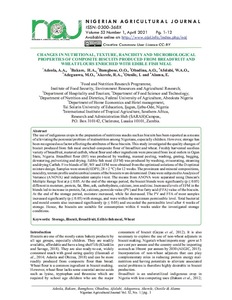| dc.contributor.author | Adeola, A.A. |
| dc.contributor.author | Bakare, H.A. |
| dc.contributor.author | Bamgbose, O. |
| dc.contributor.author | Obadina, A.O. |
| dc.contributor.author | Afolabi, W.A. |
| dc.contributor.author | Adegunwa, M. |
| dc.contributor.author | Akerele, R.A. |
| dc.contributor.author | Otesile, I. |
| dc.contributor.author | Alamu, E.O. |
| dc.date.accessioned | 2021-07-14T11:48:51Z |
| dc.date.available | 2021-07-14T11:48:51Z |
| dc.date.issued | 2021 |
| dc.identifier.citation | Adeola, A.A., Bakare, H.A., Bamgbose, O., Obadina, A.O., Afolabi, W.A., Adegunwa, M., … & Alamu, E.O. (2021). Changes in nutritional, texture, rancidity and microbiological properties of composite biscuits produced from breadfruit and wheat flours enriched with edible fish meal. Nigeria Agricultural Journal, 52(1), 1-12. |
| dc.identifier.issn | 0300-368X |
| dc.identifier.uri | https://hdl.handle.net/20.500.12478/7176 |
| dc.description.abstract | The use of indigenous crops in the preparation of nutritious snacks such as biscuits has been reported as a means of alleviating the perennial problem of malnutrition among Nigerians, especially children. However, storage has been recognised as a factor affecting the attributes of these biscuits. This study investigated the quality changes of biscuit produced from fish meal enriched-composite flour of breadfruit and wheat. Freshly harvested seedless variety of breadfruit, matured catfish, wheat flour and other ingredients were procured from local outlets in Ogun State, Nigeria. Breadfruit flour (BF) was produced by washing, manual peeling, washing, grating, bagging, dewatering, pulverizing and drying. Edible fish meal (EFM) was produced by washing, eviscerating, steaming and drying Catfish. Five blends of BF, WF and EFM were obtained from the optimised solutions of the D-optimal mixture design. Samples were stored (HDPE; 28 ± 2 °C) for 12 weeks. The proximate and mineral compositions, rancidity, texture profile and microbial counts of the biscuits were determined. Data were subjected to Analysis of Variance (ANOVA) and independent sample t-test. The means from ANOVA were separated using Duncan’s Multiple Range Test at p ≤ 0.05. At the end of the storage period, the biscuit blends were significantly (p ≤ 0.05) different in moisture, protein, fat, fibre, ash, carbohydrate, calcium, iron and zinc. Increased levels of EFM in the blends led to increase in protein, fat, calcium, peroxide value (PV) and free fatty acid (FFA) value of the biscuits. At the end of the storage period, moisture increased, while fat decreased. The PV and FFA of most samples increased significantly (p ≤ 0.05) with storage, and were within the maximum permissible level. Total bacterial and mould counts also increased significantly (p ≤ 0.05) and exceeded the permissible level after 4 weeks of storage. Hence, the biscuits are suitable for consumption within 4 weeks under the investigated storage conditions. |
| dc.description.sponsorship | Federal University of Agriculture Abeokuta |
| dc.format.extent | 1-12 |
| dc.language.iso | en |
| dc.subject | Storage |
| dc.subject | Biscuits |
| dc.subject | Artocarpus |
| dc.subject | Fish Meal |
| dc.subject | Wheats |
| dc.subject | Nigeria |
| dc.subject | Edible Fish |
| dc.subject | Food Fish |
| dc.title | Changes in nutritional, texture, rancidity and microbiological properties of composite biscuits produced from breadfruit and wheat flours enriched with edible fish meal |
| dc.type | Journal Article |
| cg.contributor.crp | Agriculture for Nutrition and Health |
| cg.contributor.affiliation | Federal University of Agriculture, Abeokuta |
| cg.contributor.affiliation | Tai Solarin University of Education |
| cg.contributor.affiliation | International Institute of Tropical Agriculture |
| cg.coverage.region | Africa |
| cg.coverage.region | West Africa |
| cg.coverage.country | Nigeria |
| cg.coverage.hub | Southern Africa Hub |
| cg.researchtheme | Nutrition and Human Health |
| cg.identifier.googleurl | https://www.ajol.info/index.php/naj |
| cg.identifier.bibtexciteid | ADEOLA:2021 |
| cg.authorship.types | CGIAR and developing country institute |
| cg.iitasubject | Agribusiness |
| cg.iitasubject | Food Science |
| cg.iitasubject | Food Security |
| cg.iitasubject | Food Systems |
| cg.iitasubject | Socioeconomy |
| cg.journal | Nigeria Agricultural Journal |
| cg.notes | Open Access Article; Published online: 30 Apr 2021 |
| cg.accessibilitystatus | Open Access |
| cg.reviewstatus | Peer Review |
| cg.usagerightslicense | Creative Commons Attribution 4.0 (CC BY 0.0) |
| cg.targetaudience | Scientists |
| cg.iitaauthor.identifier | Alamu Emmanuel Oladeji: 0000-0001-6263-1359 |
| cg.futureupdate.required | No |
| cg.identifier.issue | 1 |
| cg.identifier.volume | 52 |

